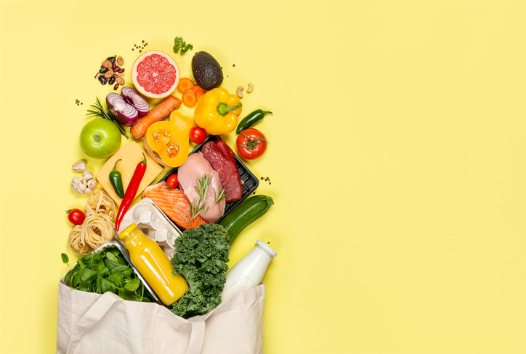
Running to the grocery store can sometimes feel like a chore. In many cases, it is. You have the goal of getting in and out of there as soon as possible, spending as little money as possible and, hopefully, not forgetting anything. But, as we feverishly browse the aisles selecting the next week's groceries does nutrition come to mind? It should! Remember, you can choose fresh, healthy foods at home only if you buy them and bring them home in the first place!
Shopping nutritiously does not have to add that much time to your trip. All you have to do is come up with a plan of action and know how to spot 'nutrient' foods vs 'calorie dense' foods. Nutrient dense foods are those that provide us lots of vitamins and minerals, and tend to be low in calories like non-starchy vegetables, whole grains, etc. Calorie dense foods are those that provide very little nutrition besides calories and contain very few essential vitamins and minerals we need to exist every day. Fast food, processed meats and foods and high calorie desserts are some examples of calorie dense foods
How do you find those nutrient dense foods?
Shop the outer perimeter of the grocery store first! This is where most of the fresh and nutrient-rich foods are kept. Try to buy seasonal and/or local fruits and vegetables, these are the freshest. The fresher the produce, the more nutrients it provides.
If your favorite fruit or vegetable is out of season, consider frozen. Frozen fruits and vegetables are picked at their peak ripeness and flash frozen, which holds in more nutrients. Out of season fruits and vegetables in the "fresh" part of the store are more likely to have been picked many weeks prior and shipped to your local store - at this point, they have lost many nutrients.
Know the good, the bad, and the ugly.
Knowing what to look for is half the battle. Here are some pointers on what to should go in your cart and what should stay on the shelf:
When it comes to fats, limit saturated fats and cholesterol (fatty meats, butter, high fat snack foods, fried foods). Avoid trans fats (hydrogenated oils) typically found in crackers, baked goods and stick margarines. Instead, opt for monounsaturated fats (olive oil, canola oil, avocados), polyunsaturated fats (corn and sunflower oils, nuts), and Omega-3 fats (fish, flaxseed, walnuts).
Aim for more fiber- these fill you up and keep you full longer. High fiber foods include whole grains, beans, fruits and vegetables, especially non-starchy. 25 grams of fiber or more per day is a healthy goal.
Try to limit your salt/sodium. High amounts of sodium can be found in deli meats, snacks like crackers and chips, canned vegetables and beans, sauces, gravies, soups, and most prepared/packaged foods.
Stick with nutrient-rich foods like fruits and veggies, whole grains, fat-free and low fat dairy products and poultry, lean meats and fish.
Learn how to read the nutrition label. Knowing how to read this handy label found on the back of many foods can help you to determine if the food is cart-worthy. Ignore all the claims that food manufacturers blaze across the front of the package and flip it over to get the true picture.
First, look at the serving size. This is sometimes the tricky part. If you eat two servings, remember you have to double all of the nutritional information that you find below on the label.
Then, look at the calories. This part goes hand-in-hand with the next part. You have to make sure that the calories come with enough nutrients to make the calories worth it. If any food has more than 400 calories per serving, that is generally too high!
Make sure that there are enough of these nutrients: Potassium, Dietary Fiber, Vitamin A, Vitamin C, Vitamin D, Calcium and Iron. This is why including fruits and vegetables into your diet is so important!
Come in with a game plan.
Shop from a list. This way you will stay focused and avoid spontaneous purchases. You can even do your research on healthy items before-hand to identify healthy choices and avoid standing in the aisle looking at labels all day.
Avoid shopping when you are hungry. Need we say more?
Don't be pressured by displays, samples or discounts. Keep your eye on the prize. It is hard to avoid the flashy and the fun items sometimes, but these items, many times, are not worth it, nutrition-wise.
So... this article should get you on your way to healthier grocery shopping. BUT, if you are looking for more tips, consider calling Chester County Hospital’s Nutrition Services to set up a nutrition appointment to dive even deeper into healthy choices at the grocery store!
Related Information from Chester County Hospital: